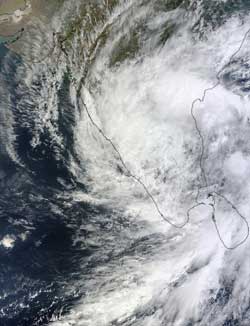NASA sees Tropical Depression Nilam blanket southern India

The MODIS instrument that flies aboard NASA's Terra satellite captured this visible image of Tropical Cyclone Nilam over southern India on Nov. 1 at 05:50 UTC (1:50 a.m. EDT).<br><br>Credit: NASA Goddard MODIS Rapid Response Team<br>
On Nov. 1 at 05:50 UTC (1:50 a.m. EDT), the Moderate Resolution Imaging Spectroradiometer (MODIS) instrument that flies aboard NASA's Terra satellite captured a visible image of Tropical Depression Nilam.
The MODIS image showed that Nilam's clouds stretched as far north as Andra Pradesh, a state in east central India. It covered the states of Goa and Karnataka in the west, all the way down to the states of Tamil Nadu, Puducherry and Kerala in extreme southern India.
On Oct. 31 at 1500 UTC (11 a.m. EDT/8:30 p.m. local time, India), Nilam made landfall over southeastern India and started to elongate. When a system is no longer circular and starts to elongate, it begins to weaken.
India's Regional Specialised Meteorological Centre (RSMC) issued a bulletin on Tropical Depression Nilam on Nov. 1 at 2 a.m. EDT (11:30 a.m. local time/India). At that time, Nilam was centered over Rayalaseema. Rayalaseema is a geographic region in the state of Andhra Pradesh. The RSMC noted that Nilam is expected to move northwestward and weaken to a remnant low pressure area later on Nov. 1.
The RSMC expects heavy rainfall over Rayalaseema, Karnataka and south coastal Andhra Pradesh and north Tamilnadu on Nov. 1 and Nov. 2 before the storm dissipates.
Media Contact
More Information:
http://www.nasa.govAll latest news from the category: Earth Sciences
Earth Sciences (also referred to as Geosciences), which deals with basic issues surrounding our planet, plays a vital role in the area of energy and raw materials supply.
Earth Sciences comprises subjects such as geology, geography, geological informatics, paleontology, mineralogy, petrography, crystallography, geophysics, geodesy, glaciology, cartography, photogrammetry, meteorology and seismology, early-warning systems, earthquake research and polar research.
Newest articles

Superradiant atoms could push the boundaries of how precisely time can be measured
Superradiant atoms can help us measure time more precisely than ever. In a new study, researchers from the University of Copenhagen present a new method for measuring the time interval,…

Ion thermoelectric conversion devices for near room temperature
The electrode sheet of the thermoelectric device consists of ionic hydrogel, which is sandwiched between the electrodes to form, and the Prussian blue on the electrode undergoes a redox reaction…

Zap Energy achieves 37-million-degree temperatures in a compact device
New publication reports record electron temperatures for a small-scale, sheared-flow-stabilized Z-pinch fusion device. In the nine decades since humans first produced fusion reactions, only a few fusion technologies have demonstrated…





















